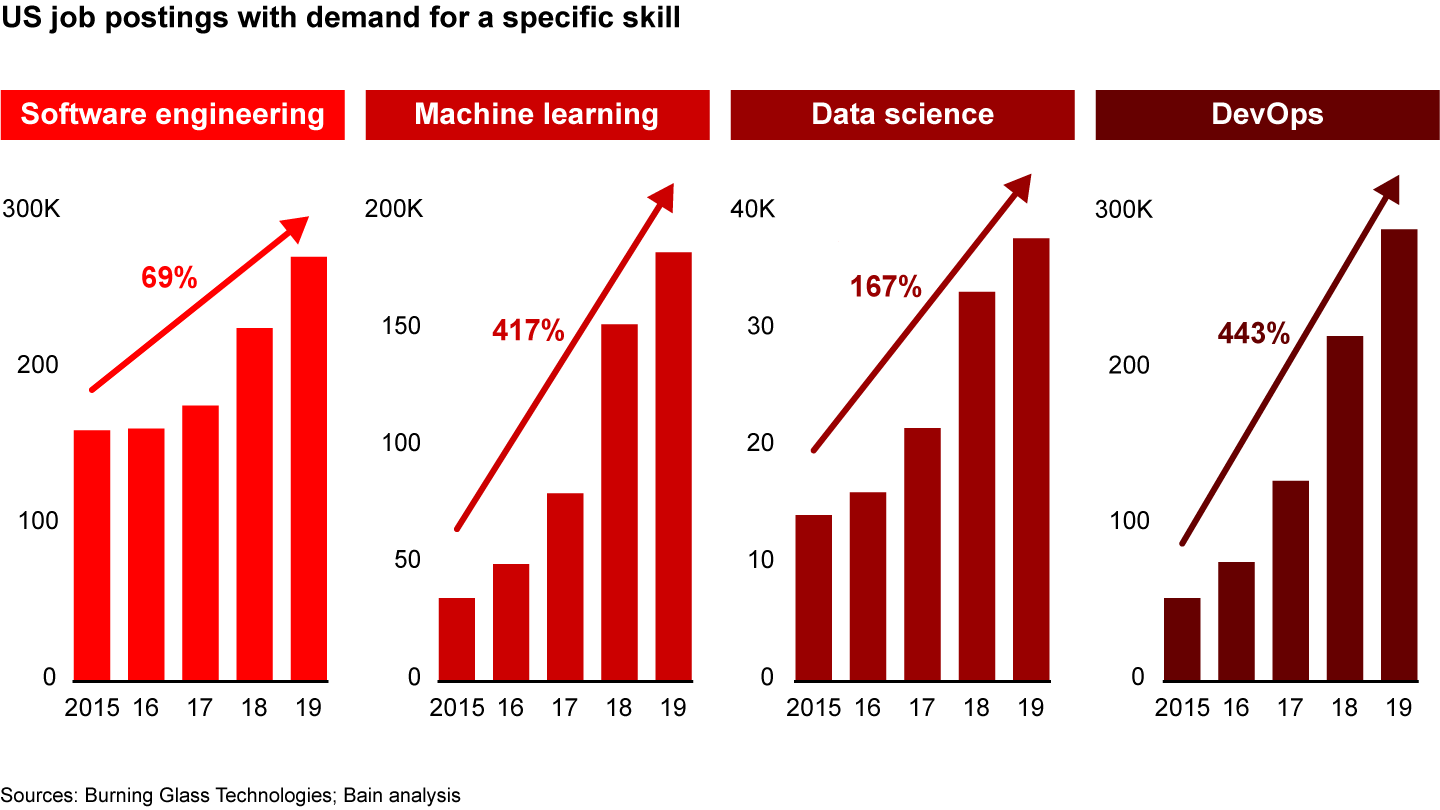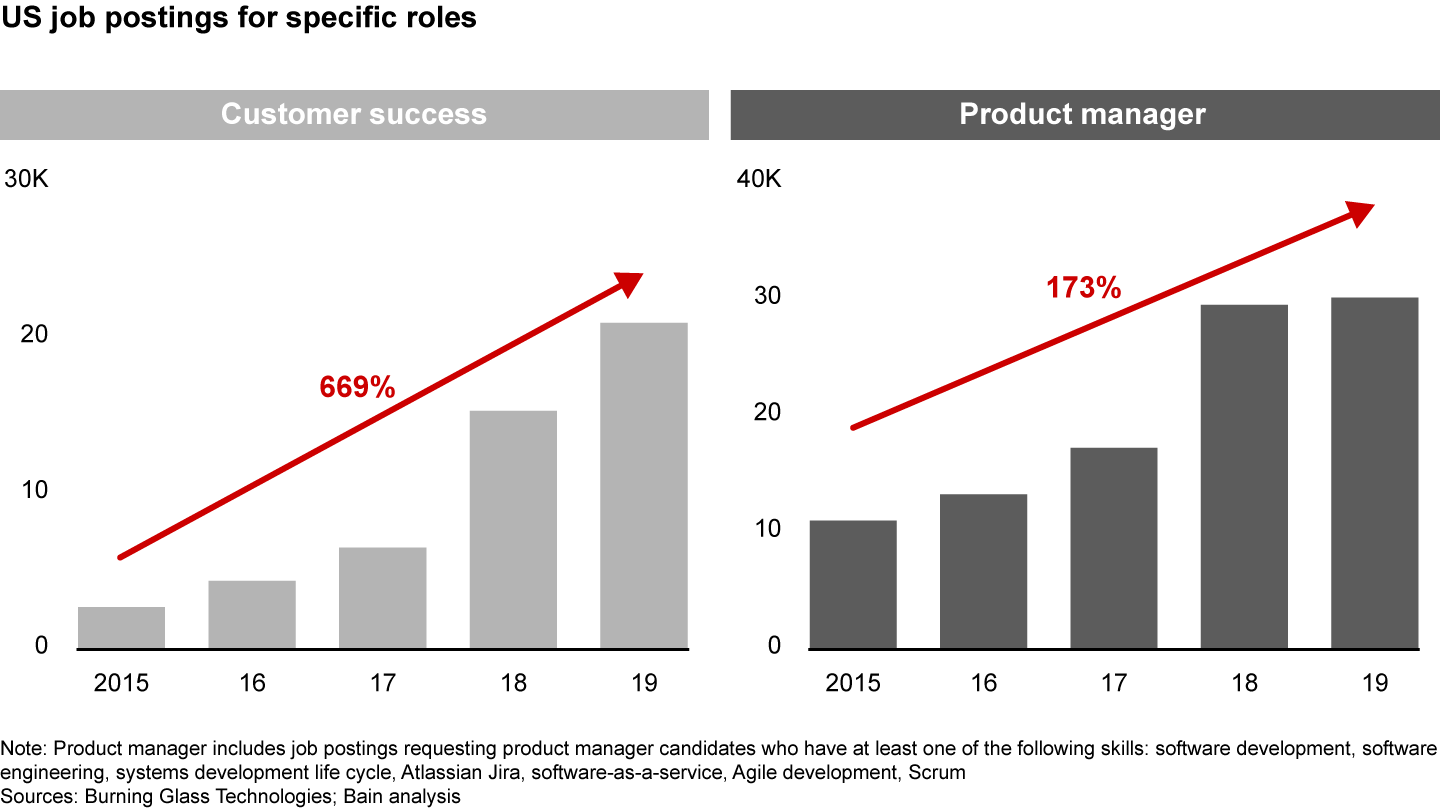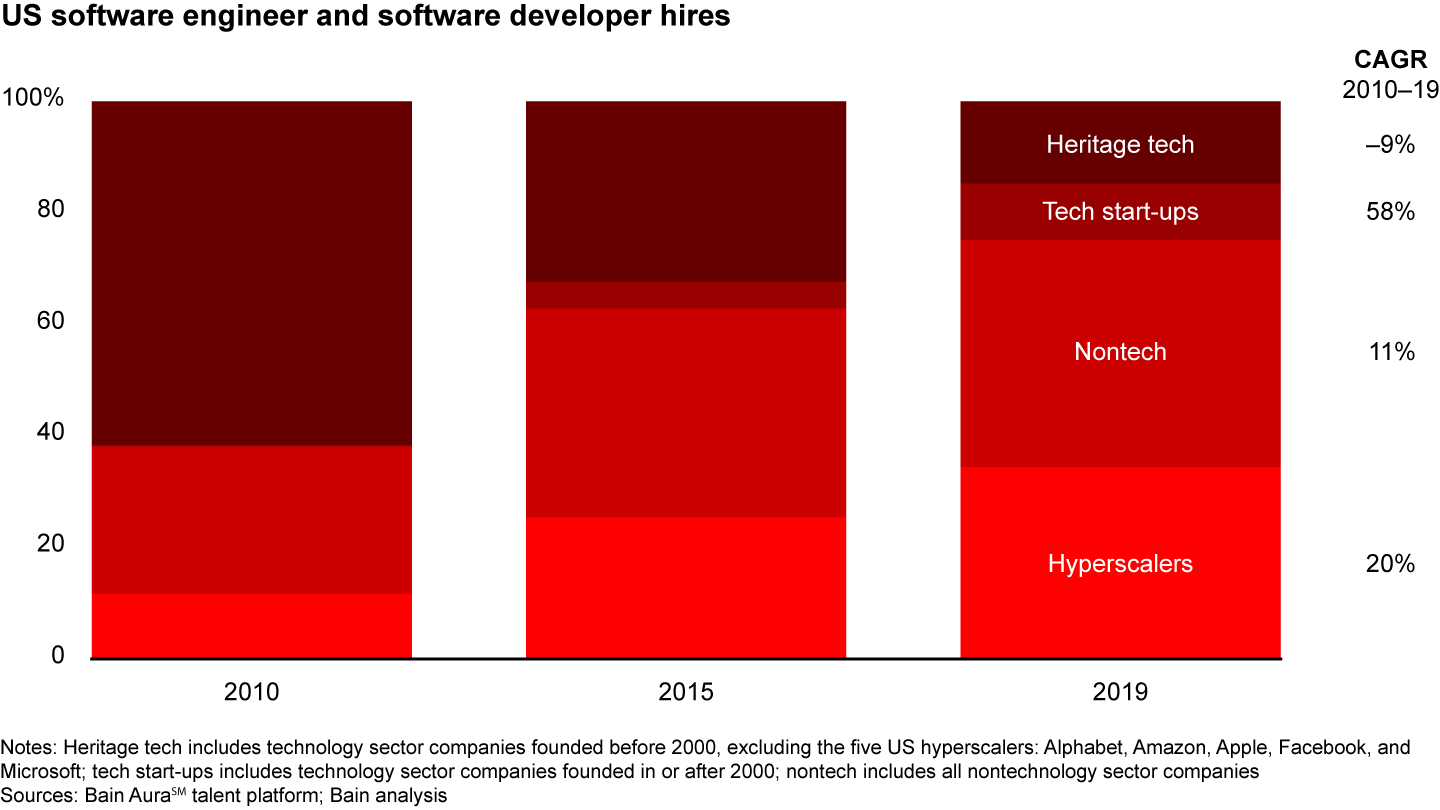Report
 }
}
This article is part of Bain's 2021 Technology Report.
With software and technology becoming mission-critical for businesses throughout the economy, CEOs in every industry are recognizing that their ability to compete comes down to one thing: having the right talent.
As a result, the war for technology talent is getting fiercer and spreading to new fronts as demand for crucial roles skyrockets. This expanding talent crunch encompasses more than just the well-documented need for data scientists, software engineers, and other technical roles (see Figure 1).

There’s also rapidly growing demand for the supporting cast that helps bring technology products to market and ensures they thrive; customer success and product managers are among the fastest-growing in this category, according to Burning Glass data on US job postings (see Figure 2).

At the same time that the scope of in-demand tech roles is widening, there are also more companies vying for them. It’s no longer just tech companies competing against one another; other industries have jumped into the race. In 2019, before the Covid-19 pandemic disrupted hiring for most companies, at least temporarily, more than 40% of software engineer and developer hires were made by nontech companies, up from about a third in 2010, according to analysis of US data using Bain’s Aura℠ talent platform (see Figure 3).

But many companies are struggling to compete for top talent because the largest technology companies—the hyperscalers Alphabet, Amazon, Apple, Facebook, and Microsoft—and tech start-ups are sucking up top-flight candidates at unprecedented rates. Last year, while many companies were furloughing or cutting staff amid the pandemic’s economic fallout, Facebook announced it would hire 10,000 additional product and engineering staff members, and Amazon was reportedly advertising more than 20,000 open tech jobs. And over the past decade, tech start-ups have been increasing the size of their software engineering and developer staffs by nearly 60% each year, the fastest hiring pace among tech and nontech companies, according to our Aura℠ analysis.
Now, it’s becoming clear that the competition for tech talent isn’t simply an HR problem. It’s about survival.

How to Win the Expanding War for Tech Talent
As all industries compete for top candidates, leading companies are widening their funnel and investing in what sets them apart.
Tech companies are more likely to be disrupted than most other industries, and once disrupted, they have more difficulty recovering than most of their peers in other sectors, according to Bain research published last year. There are several factors behind this, but executives attribute it largely to the fact that tech talent is highly mobile and difficult to retain.
The takeaway? Companies that fail to recruit and retain great tech talent are bound to lose their edge, cede ground to competitors, and, in many cases, fade away. Meanwhile, companies that adopt a winning talent strategy will have a powerful advantage that’s just as critical to their success as the competitive moat created by their technology products.
The emerging winners recognize that the key to overcoming the talent crunch is to widen their funnel of candidates by seeking those with a broader set of desired capabilities—not only technical skills—from a much more diverse pool. Then they invest in the company’s differentiators to win their target candidates.
Open the aperture beyond technical skills
Mastery of technical skills remains critical, especially for roles where software coding prowess is paramount. But for some tech roles, technical skills are less crucial. Some companies make the mistake of overemphasizing a narrow set of domain-specific skills, such as, “Does this product manager have extensive experience in my niche product category?” Rather, the right question is, “Can this product manager collaborate effectively with all stakeholders and deliver results?” For example, Google broadly defines target candidates as “smart creatives” who are “business-savvy, data-driven, technically knowledgeable power users, with creative energy and bias for hands-on approach.”
The most successful companies are focusing on a wider set of capabilities germane to each role, which can open up a larger pool of desirable candidates. These companies recognize that if they find a person who possesses the capabilities most predictive of success in the role—for example, collaboration, stress management, and self-confidence, in the case of customer success managers—the new hire can learn the rest on the job through training (formal and informal).
The art of doing this kind of search effectively depends on developing systematic processes to mitigate bias (conscious or unconscious) across the talent-acquisition and management organizations. At Airbnb, beyond giving recruiters and interviewers unconscious-bias training, hiring managers start by thinking through the objective criteria and must-have attributes for a role. Then, they define specific rubrics that align with the desired skills to minimize bias in hiring.
Invest in your differentiators
Leading companies don’t just implement measures that candidates now consider table stakes, such as a strong company mission and purpose, competitive pay and benefits packages, and investing in training and career path opportunities. These firms also create differentiators that help them beat out competitors for the most sought-after talent, including the millennials and members of Generation Z that make up a growing share of the workforce.
Based on our analysis of Glassdoor ratings of tech companies, three key factors are emerging as strong influencers on where the most talented candidates want to work.
Commitment to diversity and inclusion
Recruiting a diverse and inclusive workforce is the right thing to do, and its positive effects on business performance are well-documented. Plus, a strong diversity, equity, and inclusion (DEI) strategy can help companies attract talent because it has become an important factor in recruits’ decision making. In a Beqom survey of 1,000 employed adults last year, 48% said they’d consider switching to another company if it had a built-out DEI strategy. But companies really have no choice if they want to overcome the tech talent crunch; ignoring a huge swath of the talent pool isn’t an option.
The good news is that opening the recruiting aperture beyond typical sources of recruits helps here, too. Objectively testing for capabilities and skills rather than relying on past experience and credentials has been shown to improve diversity as well. For example, more companies are recognizing that they can find excellent software engineering candidates by scouting recruits with coding boot camp certificates and highly rated coding work samples on GitHub, regardless of whether the candidate has a computer science degree from a prestigious university. That approach opens up more opportunities for underrepresented candidates and widens the company’s talent funnel.
Transparent and accountable senior management
At high-performing tech companies, managers are usually visible and willing to engage directly with employees. They also act with speed and decisiveness, and hold themselves accountable for real outcomes. For example, Slack, the business communication and collaboration software maker, created an internal #exec-ama (“ask me anything”) chat channel. Employees can ask anything of the executive team, and executives are expected to (and actually do) respond.
Ensuring senior leaders are accountable also has a direct bearing on retaining talent. The best talent, of course, will prefer a firm where they feel their work has real impact. If employees feel leadership is intransigent and unaccountable, they’re more likely to leave to build a competing company.
Culture of coaching and development
The path to creating a winning culture can seem opaque, but one clear enabler is high-quality coaching and development of employees. Millennial and Gen Z workers tend to value this kind of investment, but it’s also critical to “growing” talented employees who have the right capabilities, but not necessarily the experience. This effort also reinforces inclusion by providing real sponsorship of employees with diverse backgrounds. For example, HubSpot moved from annual performance reviews to social performance management. It allows employees to receive continuous and instantaneous feedback from nearly anyone in the organization, encouraging ongoing skill development.
Earning a reputation for excellence across all these areas won’t happen overnight. But the payoff is a high-caliber, diverse workforce hungry to help the company succeed in the new tech-enabled economy.


